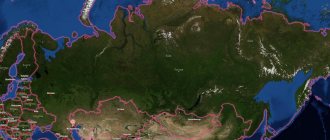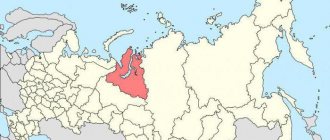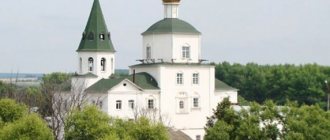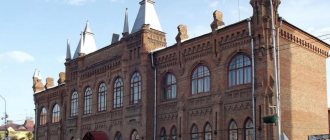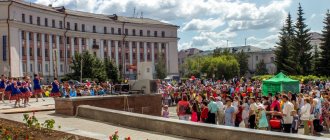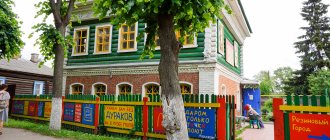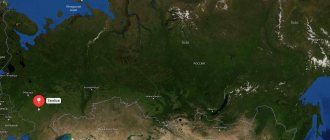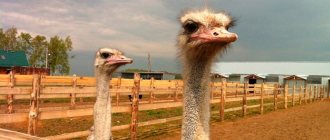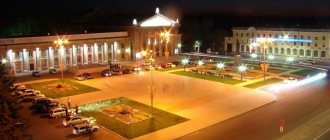Vladimir is a city in Russia, the administrative center of the Vladimir region. One of the oldest cities in Russia with a very rich history, which is a popular tourist destination in the northeast of the European part of Russia:
- 9-10 centuries - the first Slavs begin to settle on the banks of the Klyazma River;
- 1108 - foundation of the fortress of the same name by Vladimir Monomakh, which quickly turned into a city;
- 1157 - the city of Vladimir becomes the capital of the Vladimir Principality;
- 1138 and 1293 - Vladimir is attacked by the Mongol-Tatars;
- 1299 – transformation of Vladimir into the capital of “all Rus'”;
- 1491 - creation of city fortifications;
- 1609 – 1614 – raids by Polish-Lithuanian troops;
- 1778 - the emergence of the Vladimir province;
- 1920-1950 – increased industrialization of the city.
- 1960 - construction of a bridge across the Klyazma River.
The population of the city is 356 thousand people. The ethnic composition of Vladimir is quite homogeneous: Russians 95%, Ukrainians 1%, Tatars and Belarusians 0.5% each, the rest 3%.
Where is Vladimir?
Convenient location, proximity to the capital and other regional centers are attractive characteristics, thanks to which the number of tourists coming to the city is constantly increasing. Where is the city of Vladimir: in the central part of Russia on the banks of the Klyazma River, which is the left tributary of the Oka.
The settlement is located 180 km east of Moscow. You can get to it by following the M-7 Volga highway, or by rail in the direction Moscow - Nizhny Novgorod.
VLADIMIR
VLADIMIR, a city in Russia, the administrative center of the Vladimir region, forms the urban district of the same name. Population 356.9 thousand people. (2019; 345.4 thousand people in 2010, 316.0 thousand people in 2002, 349.7 thousand people in 1989, 296.4 thousand people in 1979, 234.1 thousand people. in 1970, 153.9 thousand people in 1959). Located in the central part of the East European Plain, on the border of the Vladimir Opolye and the Meshchera Lowland, on the Klyazma River. The Volga highway passes through Vladimir (Moscow - Nizhny Novgorod - Kazan - Ufa); The city is connected by highways with Murom, Ryazan, Yaroslavl and Ivanovo. Junction railway station on the Moscow – Nizhny Novgorod line, with a branch to Gus-Khrustalny. Domestic airport "Semyazino". Main gas pipeline Urengoy – Nizhnyaya Tura – Perm – Izhevsk – Kazan – Nizhny Novgorod – Vladimir – Sergiev Posad.
Story
On the territory of modern Vladimir, a settlement (presumably) of the early Iron Age, Meri settlements (8th–10th centuries), and Old Russian settlements (from the 11th century) are known. The city of Vladimir was founded ca. 1108 Pereyaslavl Prince Vladimir Vsevolodovich Monomakh. In 1157, Prince Andrei Yuryevich Bogolyubsky moved the center of the Rostov-Suzdal Principality to Vladimir, which led to the formation of the Grand Duchy of Vladimir. Vladimir reached its peak in the 2nd half of the 12th century. In 1185 it was severely damaged by fire and almost rebuilt. In the 12th–14th centuries. major center of chronicle writing.
Vladimir. Golden Gate. 1158–64, 17th–18th centuries
Vladimir. Assumption Cathedral. 1158–60, 1185–89. Photo by A. I. Nagaev
Old Russian settlements and the city were located on the cape of the Klyazma and Lybid rivers. By the middle of the 12th century. A system of wood-earth fortifications of Vladimir (preserved in fragments), surrounded by ditches, was formed, and at the same time its three-part urban structure was formed (area approximately 120 hectares; included the “Monomakhov”, or Middle, city, New city, Posad, or Vetchany city). To the city with the Detinets, which had tuff walls, white stone gates with the gate church of Joachim and Anna (1196), decorated with a carved portal, glazed tiles and a gilded copper roof. The Assumption Cathedral (1158–60, 1185–89; paintings by Andrei Rublev and Daniil Cherny, 1408) and the Demetrius Cathedral (1193–97?) were located in Dytinets. On the eastern (floor) side, the “Monomakhov” city was adjoined and connected to it through the Trade Gate by the New City, where the white-stone Golden Gate was also erected (1158–64, rebuilt in the 17th–18th centuries, white-stone arch with a tuff vault and extensions ; above it is the gate church, renewed in 1469 by V. D. Ermolin, rebuilt in 1810) and the wooden Irinin Gate. The settlement, located to the west of the “Monomakhov” city, was connected to it by the Silver Gate. In various parts of Vladimir, log-frame above-ground and half-dugout dwellings, mainly with adobe stoves, various outbuildings, palisades dividing the estates, etc., were examined.
In 1238, the city was burned during the Mongol-Tatar invasion (this event is associated with a number of discovered treasures of precious items hidden during the approach of the enemy and during the siege of Vladimir - unique sources for the study of ancient Russian culture). Subsequently, he quickly rebuilt. Despite the devastation during the Horde raids of the 13th–15th centuries. (1293, 1382, 1410), remained one of the largest Russian cities (a building in the 2nd half of the 13th–14th centuries was studied near the Demetrius Cathedral, where stained glass, numerous items imported from Eastern countries, and artistic bronze items were found). In 1299–1328 Vladimir was the residence of Russian metropolitans. Gradually towards the middle - 2nd half of the 14th century. the city ceded its role as an all-Russian political center to Moscow, while retaining its economic and commercial importance. Destroyed during the intervention of the Polish-Lithuanian Commonwealth in the early 17th century. (in 1613 there were about 600 inhabitants left in Vladimir). The advantageous position on the trade route from Moscow to Nizhny Novgorod contributed to the revival of Vladimir and the development of trade in it. The carriage trade was widespread (until the mid-19th century). From 1719 the center of the Vladimir province of the Moscow province, in 1778–1929 the center of the Vladimir province (until 1796 - the Vladimir governorship). “Vladimirka” passed through Vladimir - the road along which exiles went from Moscow to Siberia. At the end of the 18th century. the Vladimir Central was founded (before the October Revolution of 1917 - a transit prison; in the 20th century, M. V. Frunze, L. A. Ruslanova, the son of I. V. Stalin - V. I. Stalin, D. L. Andreev and etc.; in 1996 a museum was created at the prison, opened in 1997). In 1862, traffic began on the Moscow-Nizhny Novgorod railway, passing through Vladimir. In Oct. / Nov. 1917 owl was installed in the city. power. In 1929–36 the regional center of the Ivanovo Industrial Region, in 1936–44 of the Ivanovo Region, from 1944 the administrative center of the Vladimir Region. Since 2004, the center of the city district of the same name.
Architecture
Large stone construction in Vladimir took place in the 2nd half of the 12th century, when the Vladimir-Suzdal school emerged in Russian architecture. The white stone architectural monuments of Vladimir are included in the World Heritage List. At the beginning of the 16th century. In the traditions of Moscow architecture, the Assumption Cathedral of the Princess Monastery was erected (paintings with the composition “The Last Judgment”, 1647–48, artist Mark Matveev and others). The Assumption Church (1644–49) was built in the forms of townsman architecture. The traditional type of “octagon on a quadrangle” includes the churches of St. Nicholas in Galei (1732–35), Trinity (1740), distinguished by their slenderness and exquisite decor. Baroque monuments - the Bishop's Chambers of the Nativity Monastery (1748), the Church of St. Nikita the Martyr (1762–65), the iconostasis of the Assumption Cathedral (1768–74). The churches of St. George (1784–96) and Nikolo-Kremlevskaya (1769) have Baroque decor. According to the regular plan of 1781 (implemented with significant adjustments), a three-part urban structure was preserved with a main street common to all three parts; each of them received a rectangular grid of streets, which were built up with houses according to exemplary designs (partially preserved). The Churches of the Presentation (1807) and Prince Vladimirskaya (1785) were built in the style of early classicism. The main works of classicism are Public places (1785–90, presumably architect K. I. Blank), Shopping arcades (1787–93, architects N. P. von Berk, A. I. Chistyakov), the complex of the Noble Assembly and the men's gymnasium (1825 –27, 1837–41, architects V. A. Dregalov, E. Ya. Petrov), governor’s house (1787). The combination of elements of classicism and neo-Gothic is characteristic of the bell tower of the Assumption Cathedral (1810). Buildings in the neo-Russian style - the City Duma (1907, architect Ya. G. Revyakin), the building of the Historical Museum (1900–06, architect P. G. Begen), the Church of St. Michael the Archangel (1891–93, architect A. P. Afanasyev) and Trinity (1913–16, architect S. M. Zharov), Red Cross Hospital (1914–16, architect L. M. Scherer). Neo-Gothic church (1891, architect I. A. Karabutov). The People's House of the Temperance Society (1904–05, 1907, architects Revyakin, Begen) and the Real School (1907–08, architect P. A. Vinogradov) are in the Art Nouveau style. Neoclassical cinema "Empire" (1913, architect Zharov); Among the buildings of the post-war period is the Palace of Culture (1954). The building of the Drama Theater (1970; architect G. P. Gorlyshkov). Monuments: 850th anniversary of Vladimir (1960, sculptor D. B. Ryabichev, architect A. N. Dushkin), Alexander Nevsky (1963, sculptor S. M. Orlov), Andrei Rublev (1995, sculptor O. K. Komov), 2000th anniversary of the Nativity of Christ (author M. I. Gelvanovsky, blacksmith Yu. A. Zimin), etc.
Centers of science and culture
Universities: State University named after. A. G. and N. G. Stoletov (founded in 1958 as a branch of the Moscow Evening Engineering Institute, current status since 1996; in 2011 it included the State Humanitarian University, founded in 1919); institutes: business (1991), legal FSIN of Russia (history dates back to 1943, current status since 1996), tourism and hospitality (2007).
Libraries: regional scientific named after. M. Gorky (1897), central city (1946), for children and youth (2011), etc.
State Archive of the Vladimir Region (history dates back to 1918, current status 1922–29 and 1944; in 1929–44 as part of the Ivanovo Regional Archive).
Vladimir-Suzdal Historical, Art and Architectural Museum-Reserve (1854, modern name since 1958; includes exhibitions and interiors of the Assumption and Dmitrievsky Cathedrals, a historical museum, a military-historical exhibition in the Golden Gate, the "Old Vladimir" museum in a former water tower, an exhibition “Crystal, lacquer miniature, embroidery” in the Old Believer Trinity Church, Stoletov House-Museum, Museum of Nature). Other museums: Vladimirsky, gingerbread, fairytale museum “Granny-Yagusya”. Art gallery (1995; in the building of former government offices; Russian art of the 18th – early 20th centuries). Exhibition Center (2011).
Theatres: academic regional drama named after A.V. Lunacharsky (1848), puppet theater (1969), municipal folklore theater “Razgulay” (1993).
Philharmonic Society (1944), consisting of: State Vocal and Choreographic Ensemble “Rus” named after. M. Firsova, orchestra of Russian folk instruments, chamber string orchestra, ensemble “Native Tunes”, pop dance ensemble “Exclusive”. Centers: choral music of Vladimir-Suzdal Rus' (1992), classical music (2004). Concert Hall named after. S. I. Taneyeva (1967). Planetarium (1962). All-Russian open competition of romance performers (1995; held once every 3 years).
Sport
Football stadium "Torpedo" (opened in 1950; has 18.5 thousand seats), where the team of the same name plays its home matches (founded in 1959; in the 2020/21 season it plays in the "West" zone of the Professional Football League championship). The Vlada women's mini-football club won silver (1994) and bronze (1995) medals at the Russian Championship. Gymnastics and winter sports (cross-country skiing, biathlon, ice skating) are very popular in the city.
Farm
The basis of the city economy is the service sector; its leading sectors are administrative, financial, transport and logistics services, trade, education and tourism business. Vladimir accounts for 49.9% of Vladimir's retail trade turnover. (RUB 112.6 billion, 2018). Vladimir is a major tourism center, one of the main points on the “Golden Ring of Russia” route. The hotel industry plays an important role in the city’s economy (the main hotel complexes are “Vladimir”, “AMAKS Golden Ring”, “Zarya”, “Klyazma”, “Orion”, “Vladimirsky Dvorik”).
The leading industry is mechanical engineering. The following factories operate: motor-tractor (production of Agromash tractors, attachments, tractor engines), electric motor (alternating current motors), Elektropribor (communications and radio devices), Tochmash (as part of the state corporation Rosatom); equipment for storing spent nuclear fuel, radio fuses and safety-actuating mechanisms) and NPO Magneton (magnets, magnetic systems and separators).
The chemical industry is represented by plants: chemical (production of polyvinyl chloride plastic compounds, fiberglass, thermoplastic sheets), (in the structure of the American Dow Chemical Company; components for the production of polyurethane foams and thermoplastics), Acrylan (acrylic and styrene acrylic dispersions), Research and Development Enterprise "Vladipur" (polyurethane foam and products made from it, polyurethane adhesives, furniture foam rubber), "Greiner Packaging" (a division of the Austrian "Greiner Packaging"; plastic packaging materials for food products), factory of the Federal Center for Animal Health (biological products for diagnostics, prevention and treatment of infectious animal diseases).
Among the light industry enterprises are the following factories: “Vladimir Textile” (production of tarpaulins with special impregnations) and “Sudar” (sewing products: jackets, trousers, men’s suits, etc.). An important role is played by the wood processing (timber processing complex; production of lumber and laminated veneer lumber) and food processing [bakery, meat processing, distillery "Vladalko", production of crackers "Bridgetown Foods", etc.] industry, production of building materials (reinforced concrete products and bricks) , stainless steel pipes (Marchegalia ru enterprise, part of the Italian company). The main producer of electricity and thermal energy is Vladimir CHPP-2 (1962; installed capacity 596 MW, fuel - natural gas and fuel oil).
Neighborhood
Near Vladimir is the village of Bogolyubovo, the former residence of the Vladimir prince Andrei Yuryevich Bogolyubsky.
Vladimir map
Having looked at where the city of Vladimir is located on the map, we can conclude about its favorable economic and geographical position. It is located near major cities of Russia: the distance to Nizhny Novgorod is 235 km, to Ivanovo 115 km, to Kolomna 211 km, to Yaroslavl 229 km, to Kostroma 220 km.
Thanks to the city’s favorable location, its residents have a good opportunity to travel around the European part of Russia without special expenses. The proximity of other large settlements, located 2-2.5 hours away by car, simplifies the life of the population. If necessary, people can easily get to the nearest city to solve their problems.
Road transport
One of the largest federal highways, the M7 Volga, passes through Vladimir. The road starts in Moscow and runs east through Vladimir, Nizhny Novgorod and Ufa (end point). There are many branches from the M7 Ural highway to intermediate (Moscow - Ufa) settlements. Formally, the M7 is a continuation of another federal highway, the M5 Ural, connecting the European and Asian parts of Russia.
Due to the fact that Vladimir is one of the cities of the “Golden Ring of Russia”, the most important road routes from a tourism point of view are:
- Regional highway P74. Currently, the highway is divided into sections 17A-1 (in the Vladimir region) and 78K-0041 (in the Yaroslavl region). The road connects Vladimir with Yuryev-Polsky and then goes to Pereslavl-Zalessky.
- Regional highway P73 (divided into sections 17R-2 in the Vladimir region and 61K-002 in the Ryazan region). It is a continuation of the P74 highway after it crosses the M7 Volga federal highway. P73 directly connects Vladimir with Ryazan and then goes to Tambov.
- Regional highway P123. Currently has registration number 61K-003. The route connects Vladimir with Ryazan, Solotcha, Spas-Klepiki, Tuma, Kasimov and Nizhny Novgorod. At this time, the possibility of assigning federal status to this road is being considered.
Population of Vladimir
According to statistics available to the federal government service, the population of Vladimir has not changed much over the past few years. From 2002 to 2010, the number of residents increased by almost 10%. From 2010 to 2015, the number of people living in the city increased by 1.5%. From 2015 to 2019, there was a slight increase in population. In percentage terms, it is 0.25-0.3%.
Statistical data:
| Year | Population of Vladimir |
| 2002 | 315,954 people |
| 2010 | 345,373 people |
| 2013 | 347,930 people |
| 2014 | 350,087 people |
| 2015 | 352,681 people |
| 2016 | 354,827 people |
| 2017 | 356,168 people |
| 2018 | 357,024 people |
| 2019 | 357,907 people |
| 2020 | 356,937 people |
Golden Gate
Some historians believe that there were no analogues to the Vladimir Golden Gate in all of Europe. There were either towers, at most, with a narrow passage, or powerful gates, separate from the towers. The Golden Gate combined the advantages of both towers and gates.
The Golden Gate was built by Andrei Bogolyubsky when Vladimir became the capital of the principality in the 12th century. The cubic structure topped by the church with towers on the sides captured the imagination of people no less than the gate itself, upholstered in sheets of polished copper. The gates also served a defensive function, for which they had loopholes and platforms for shooters, and a representative function - they served as a kind of triumphal arch.
The defense of the main entrance to Vladimir was also helped by an earthen rampart with a ditch, over which a bridge was thrown.
Enemies and fires did not spare the Golden Gate; they constantly needed to be repaired and renovated. All that remained of the original gate was the arch (and even its fragments were rebuilt), the battle platform above it, and the side pylons. The remaining parts of the gate were restored or even rebuilt. Nevertheless, the Golden Gate remains one of the symbols of Vladimir. And the gate, which many consider truly golden, is still being searched for.
Now there is a museum in the Golden Gate. It displays various historical artifacts with military themes. The central part of the exhibition is a diorama depicting the defense of Vladimir from Batu’s troops in 1238. The entrance ticket costs the traditional 150 rubles.
Sights of Vladimir
Rich in centuries-old history, the city is famous for its large number of attractions. Some architectural monuments have been included in the UNESCO list of World Cultural Heritage Sites. I advise you to visit and see with your own eyes the following sights of Vladimir:
- A unique architectural ensemble and monument to Russian icon painter Andrei Rublev on Cathedral Square.
- The structure of the architecture of Ancient Rus' The Assumption Cathedral is considered an example of white stone architecture. The building was built before the Mongol-Tatar invasion.
- Demetrius Cathedral, built in the 12th century in honor of St. Demetrius of Thessalonica.
- The Golden Gate, erected in 1164, opened the entrance to the richest and most respectable part of the city.
- Mother of God Nativity Monastery, which has long been considered the center of spiritual life.
- The Historical Museum was built at the beginning of the 20th century.
- The Gingerbread Museum, where you can learn the history of the delicious treat and try it yourself.
- With about 7,500 exhibits, the Spoon Museum. Operating since 2015, the museum contains unique and unusual spoons that were used at different times.
Dmitrievsky Cathedral
This cathedral is in direct visibility from the Assumption Cathedral, and Demetrius Cathedral was built only a few decades later than its neighbor. It seems that it is not the best solution to build two cathedrals on a small patch of land. However, everything is justified - the Assumption Cathedral is for everyone, a cathedral church. And Dmitrievsky was built as the house church of Vsevolod the Big Nest. The family of this great prince needed a larger church - after all, 12 children!
The current appearance of the temple is even slightly frightening with its asceticism: the naves crowded closely to the center, the walls bare up to half the height, the absence of decorations on the portals. The thing is that restorers in the 19th century overdid it when restoring the original appearance of the temple (Dmitrievsky Cathedral often burned and collapsed). They demolished the gallery around the first floor and the tower with stairs, considering their later additions.
However, it turned out that the galleries were functional - they held together the building, which began to crack after their demolition. It was difficult to stop the destruction. It’s good that they didn’t touch the carvings decorating the walls at the height of the third tier. There, the stone is decorated not only with images of saints, but also with numerous animals, real and imagined. There are even illustrations of the labors of Hercules and Alexander the Great. Before the ill-fated 19th century, the temple was dark red, and the white carvings stood out perfectly against the red background. Now you need to take a closer look at the unique stone painting.
The inside of the cathedral is also ascetic; the walls are mostly bare. After numerous fires, only a very small part of the frescoes survived. The 12th-century paintings, discovered in 1843, are part of the “Last Judgment” composition. In the central vault under the choir there are 12 figures of apostle-judges on thrones and angels behind them.
The painters who created the frescoes probably arrived in Vladimir from the Byzantine city of Thessalonica.
The temple was not transferred to the Orthodox Church, but is part of the Vladimir-Suzdal Museum-Reserve. You can visit it from 10:00 to 17:00 on all days except Tuesday. The ticket costs 150 rubles.
History of Vladimir
From historical documents it follows that the construction of Vladimir began earlier than Moscow. Some historians claim that its founder was Vladimir Monomakh. According to this version, the first stone was laid in 1108. Other historians believe that the baptist of Ancient Rus', Vladimir Svyatoslavovich, began the construction of a fortress on the banks of the Klyazma River in 990. The history of Vladimir began with the foundation of this building.
From the middle of the 12th century, the ancient city became the capital of the Vladimir Principality. The formation of the modern Russian state began from its lands. I believe that a visit to Vladimir will be useful for people interested in their roots and the history of Russia. By visiting museums, admiring architectural monuments, walking along narrow streets surrounded by greenery, tourists will be able to enjoy the beauty and originality of the ancient city, which is part of the Golden Ring of Russia route.
Economy and industry of Vladimir
The basis of the city's economy is the manufacturing industry, half of which comes from the food industry. The largest organizations in this field:
- OJSC "Vladimir Bread Factory"
- Vladimirsky Distillery,
- OJSC "Vladimir Milk"
The chemical, mechanical engineering and energy industries, represented by the following enterprises, have a significant impact on the city’s economy:
- JSC "Avtopribor"
- OJSC "Vladimir Motor and Tractor Plant",
- PJSC "Vladimir Chemical Plant",
- Vladimir CHPP-1 and CHPP-2.
Information sources:
- Official website of the Administration of the Vladimir Region
Water tower
A very nice water tower building was built in 1912 by Sergei Zharov, who served as the city architect of Vladimir. He completed the project in the neo-Russian style popular at the beginning of the 20th century - made of brick, but with pointed arches and small cornices over the windows.
The building served as a water tower until the reconstruction of the water supply system in the 1950s. In 1975, the Old Vladimir Museum was opened in the water tower. Gradually the exhibition grew and filled all three floors.
On the first floor there is a story about the economy of pre-revolutionary Vladimir, the second exhibition presents prominent residents of the city, the exhibits on the third floor tell about the cultural and spiritual life of Vladimir. And on the fourth, half-open floor there is an observation deck.
Vladimir Central
Known to every Russian thanks to the song by Mikhail Krug, the prison arose as a transit point on the way to Siberia under Catherine II. “Mother,” as we know, did not apply the death penalty, but she had great honor in other ways of influencing rebellious subjects. Every year dozens of people were sent to hard labor in Siberia. In the Vladimir Central they were collected in stages and sent to regions from which it was almost impossible to get out.
Gradually the central turned into a place for serving sentences. In it they kept those who did not risk being sent even to Siberia, and those who had to remain in captivity, but “at hand.”
The walls of the Vladimir Central saw a variety of convicts. Basically, these were “politicians”, but there were also thieves and murderers, there were even captured Germans. Now in the central prison there are prisoners convicted of especially serious crimes: terrorism, mass murder, etc.
The Vladimir Central has its own museum. Its exhibits tell about the history of the prison, conditions of detention, famous prisoners, and even the creativity of prisoners is presented.
